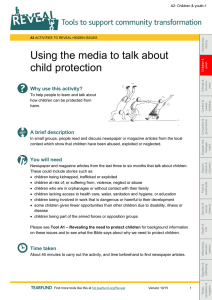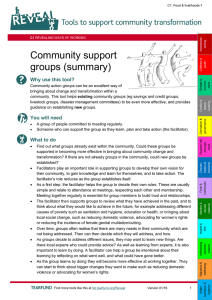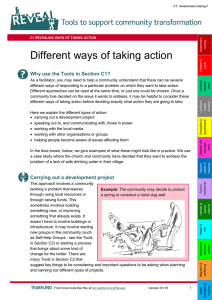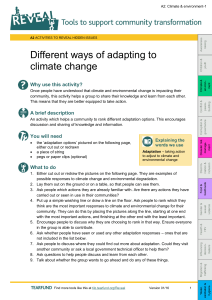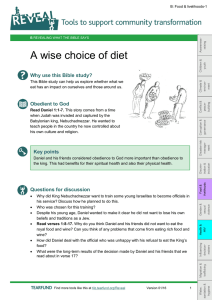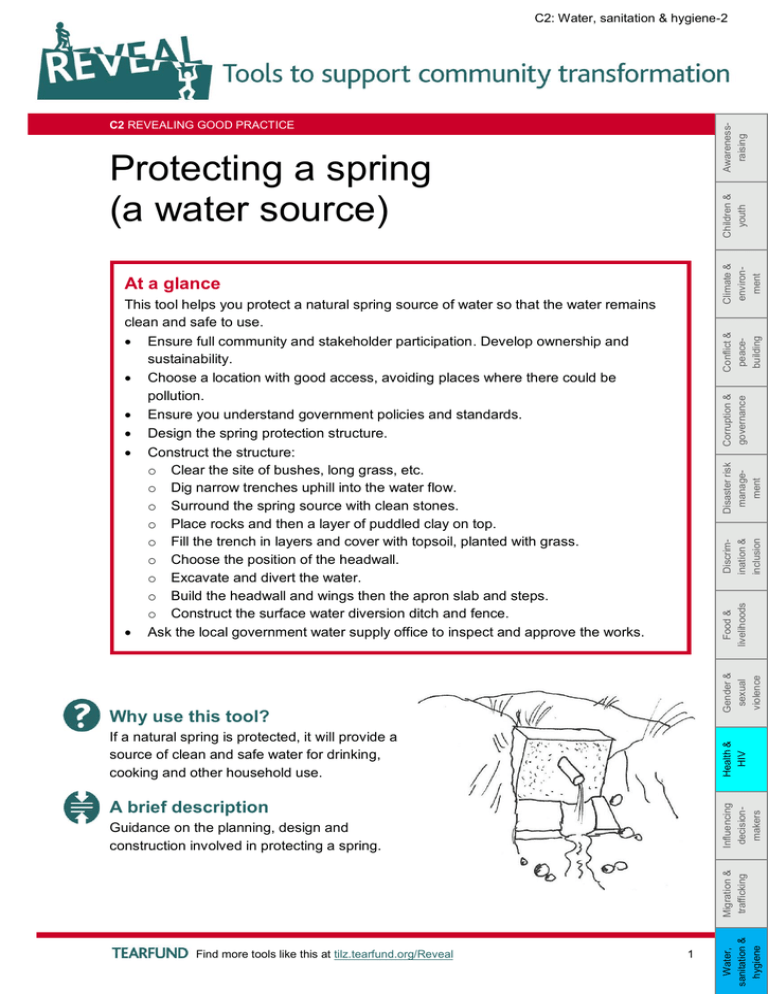
C2: Water, sanitation & hygiene-2
Awarenessraising
C2 REVEALING GOOD PRACTICE
Climate &
environment
Children &
youth
Protecting a spring
(a water source)
At a glance
Gender &
sexual
violence
Food &
livelihoods
Discrimination &
inclusion
Disaster risk
management
Corruption &
governance
Conflict &
peacebuilding
This tool helps you protect a natural spring source of water so that the water remains
clean and safe to use.
Ensure full community and stakeholder participation. Develop ownership and
sustainability.
Choose a location with good access, avoiding places where there could be
pollution.
Ensure you understand government policies and standards.
Design the spring protection structure.
Construct the structure:
o Clear the site of bushes, long grass, etc.
o Dig narrow trenches uphill into the water flow.
o Surround the spring source with clean stones.
o Place rocks and then a layer of puddled clay on top.
o Fill the trench in layers and cover with topsoil, planted with grass.
o Choose the position of the headwall.
o Excavate and divert the water.
o Build the headwall and wings then the apron slab and steps.
o Construct the surface water diversion ditch and fence.
Ask the local government water supply office to inspect and approve the works.
Why use this tool?
Health &
HIV
If a natural spring is protected, it will provide a
source of clean and safe water for drinking,
cooking and other household use.
Influencing
decisionmakers
A brief description
Find more tools like this at tilz.tearfund.org/Reveal
1
Water,
sanitation &
hygiene
Migration &
trafficking
Guidance on the planning, design and
construction involved in protecting a spring.
C2: Water, sanitation & hygiene-2
C2 PROTECTING A SPRING (A WATER SOURCE)
Awarenessraising
Why protect a spring?
Children &
youth
A spring is a place where groundwater (water that is stored in the ground) naturally
flows from the earth's surface. Before it reaches the surface, spring water often moves
downhill through soils or cracks in rock until the water is at the same level as the
ground. The main aim of spring protection is to protect water so it is safe to use. Before
reaching the surface, spring water is usually very clean. However, groundwater can
become contaminated as it leaves the ground surface, and even before then if polluted
water mixes with it. Clean spring water can be made dirty from the waste of animals and
humans who defecate near to the spring. Septic systems and fuel tanks close to the
spring can also contaminate the water, as can pesticides, fertilizers and industrial waste.
Therefore, spring water sources need to be protected.
Climate &
environment
Conflict &
peacebuilding
Corruption &
governance
The words we use
Disaster risk
management
Contamination – water being made dirty or ‘infected’ from faeces or other substances.
Spring headwall – a concrete wall at the spring outlet that protects against scouring or
undermining of the spring structure
Apron – the concrete bed in front of the headwall, over which water flows. It stops the
water from washing away the soil, undermining the headwall or changing course
Puddled clay – clay soil that has been compressed and smeared, so that it forms a
dense, water-tight layer. Using bare feet is an effective way of puddling clay.
Discrimination &
inclusion
Time taken
Food &
livelihoods
Site preparation and construction can take between one and three weeks. It is important to
measure the flow of the spring in the dry season, to ensure that there is enough water for the
community all year-round.
You will need
Gender &
sexual
violence
Health &
HIV
Influencing
decisionmakers
At least 4 people to clear the site and build the protection structure.
Picks, shovels, spades, flat-ended iron rods for digging, cement trowels, a spirit level, a
hammer, nails, a wood-saw, buckets, and a watch with a second hand.
Cement, sand, gravel, a reinforcement bar (used in reinforced concrete), lengths of
timber and plywood to make a mould to hold wet concrete, a length of galvanised (rust
proof) iron pipe (I ½ -inch diameter), lengths of PVC pipe (I ½ -inch diameter), a source of
clay soil / heavy clay, and rocks to form the foundation of the spring apron.
A suitable spring source which gives enough flow all year round.
Information on how many people are likely to use the spring.
Migration &
trafficking
Water,
sanitation &
hygiene
Find more tools like this at tilz.tearfund.org/Reveal
2
C2: Water, sanitation & hygiene-2
Awarenessraising
C2 PROTECTING A SPRING (A WATER SOURCE)
Keys to success
Disaster risk
management
Corruption &
governance
Conflict &
peacebuilding
Climate &
environment
Children &
youth
Location: the spring should not be more than 500 metres from the homes of people
who will use it. It must be at least 50 metres away from any latrine, garbage area, or
other source of pollution, and never be sited down-slope of a latrine or defecation
area. Also, ensure the spring site is not in a place that experiences flooding or it risks
being washed away.
Legal standards: ensure compliance with legal requirements including national water
access policies. Also, be sure of land-ownership rights, both where the spring itself is
located, and access to the spring by users.
Spring outlet: ensure the outlet is not above the true source of the spring.
Quantity of water: ensure the spring doesn’t run dry – plants can help to replenish
the aquifer.
Participation: ensure the full participation of men, women and children, and
vulnerable groups. Ensure that vulnerable community members are involved in the
design, planning and management. Engage the community in providing the labour for
preparation and construction. Encourage the community to form a Water Users
Committee to manage the project and to ensure fair access to, and use of, the water.
Sustainability: ensure a fair process is in place to help pay for maintenance of the
protected spring structure.
Start by finding out whether the national and/or local government has a policy or strategy for
ensuring people in your area have access to safe and clean water. For example, there may
be a national minimum standard of safe water quantity per person per day, or there may be a
specific policy on payment or subscriptions for a community water supply. If this is the case,
you may want to consider advocacy, calling on them to fulfil their responsibility, and seeing
how you could work with them in the provision of water supply. See Section B1 for tools and
guidance on advocacy, including Tool C1 – Advocacy – communicating with people in
power.
Health &
HIV
Ensure ownership and sustainability
3
Water,
sanitation &
hygiene
Migration &
trafficking
Influencing
decisionmakers
Ensure that women, men and children
from the community participate in the
design, planning and management of the
spring structure. Ensure that vulnerable
members of the community (single
parents, people with HIV, people with
disabilities) are fully involved.
Find more tools like this at tilz.tearfund.org/Reveal
Gender &
sexual
violence
Understand the policy environment.
Food &
livelihoods
Discrimination &
inclusion
What to do
C2: Water, sanitation & hygiene-2
C2 PROTECTING A SPRING (A WATER SOURCE)
Awarenessraising
Children &
youth
Climate &
environment
Encourage and guide the community into forming a Water Users Committee (WUC). The
WUC is a group of people who will manage the spring protection project, for example the
finances, design, construction and community contributions. They may need to receive
training in how to manage these different parts. Their role is also to ensure fair access to,
and use of, the water. It is good practice for the WUC to appoint someone to monitor the
spring structure, and at least two care takers to maintain and repair it.
The WUC, and other key stakeholders, such as community health volunteers and
representatives of the local government water supply office, should form their own Water
Safety Plan, which will help them to protect water quality, and ensure that the benefits of
the project are maintained.
Ensure a fair process is in place to help pay for maintenance of the project.
Decide the spring location.
Conflict &
peacebuilding
Corruption &
governance
Disaster risk
management
Discrimination &
inclusion
The spring should not be more than 500
metres from the homes of people who will
use it. If it is much greater than this, you
could consider constructing a simple pipeline
to transfer the water to a storage tank.
Will you need to build an access path or
steps?
Make sure the spring site is not in a place
that experiences flooding or it risks being
washed away. You may need to build drainage ditches to divert flood water.
Ensure the spring is at least 50 metres away from a latrine, garbage area, or other source
of pollution. The spring must not be sited down-slope of a latrine or defecation area.
If the land is privately owned you need written permission to develop and use the spring for
community purposes. Make sure people will be able to walk over the land to access the
spring.
Food &
livelihoods
Ensure you understand government policy and standards
Gender &
sexual
violence
Is there a national water policy which gives minimum standards for water quantity and
quality, as well as the appropriate distance from the supply to people’s homes?
Is the local district government water department aware and supportive of your project? It
may be useful to include them in the design, planning and construction of the spring
structure.
Health &
HIV
Design the spring protection structure.
Influencing
decisionmakers
Migration &
trafficking
Is the spring concentrated at a single point in the ground or slope, or spread a few metres
across the ground? This will determine the type of protection structure needed.
Measure the flow by timing how long the water takes to fill a container of known volume.
Decide whether or not you will need to build a storage tank to collect the water so that
there is enough flow available at the time people use it most.
Ensure the outlet is not above where most of the spring water comes out, and that this
location is never flooded. If you build the spring protection too high, its weight could hold
Water,
sanitation &
hygiene
Find more tools like this at tilz.tearfund.org/Reveal
4
C2: Water, sanitation & hygiene-2
C2 PROTECTING A SPRING (A WATER SOURCE)
Find more tools like this at tilz.tearfund.org/Reveal
5
Corruption &
governance
Migration &
trafficking
Water,
sanitation &
hygiene
The spring source at the head of the trench should be surrounded with clean stones
through which water can flow into the trench. Stones of between 10 and 40mm size are
most suitable, laid to a depth of at least 100mm. On top of this lay some larger rocks, and
then a layer of puddled clay 100mm deep. This is clay prepared by wetting and kneading
underfoot until it is evenly firm. Its purpose is to prevent surface water and replaced earth
from entering the stone-filled channel.
Influencing
decisionmakers
Health &
HIV
Gender &
sexual
violence
Food &
livelihoods
Discrimination &
inclusion
Clear the site of bushes, long grass, etc.
Engage the community in bringing
Starting at the highest point(s) at which there is
the necessary sand and gravel to the
evidence of water coming from the ground, dig
site, preparing the site and building
narrow trenches downslope. Stop when the
the spring protection structure.
trench is about 1.0 metre deep, if there is a lot
of water flowing into the trench.
If there is more than one main source, several trenches can be joined. This takes a bit of
work to be sure you’ve found the place where most of the water comes from the ground. If
you get this wrong you could cause the spring to come out of the ground somewhere else.
Ask for help from your local government water technical officer.
Disaster risk
management
Construct the spring protection structure.
Conflict &
peacebuilding
Climate &
environment
Children &
youth
Awarenessraising
the water back and it may cause the spring flow to move to another location on lower
ground.
The area around and above the spring must
be fenced off to stop animals entering.
Find out the ‘catchment area’ for the spring.
This is the wider area which captures and
directs ground water or surface water to
supply the spring. The local government
water department may be able to tell you.
Think of ways to protect this area. Planting
trees and bushes or making earth bunds or
contours will help rainwater to seep into the
ground to replenish the water supply.
C2: Water, sanitation & hygiene-2
C2 PROTECTING A SPRING (A WATER SOURCE)
Awarenessraising
Children &
youth
Climate &
environment
Conflict &
peacebuilding
Corruption &
governance
Once the clay has been trodden into
place, the remainder of the trench can
be filled with the earth you dug-out. It is
best to compact it using your feet in
layers of about 100mm. The final layer
in the trench should be topsoil, which is
planted with creeping grass plants to
prevent it being washed away.
Disaster risk
management
Choose the position of the concrete headwall: the closer the headwall is to the eye of the
spring, the higher and stronger the wall will need to be. A smaller headwall further away
from the eye may be the cheapest solution:
Discrimination &
inclusion
Food &
livelihoods
Gender &
sexual
violence
Health &
HIV
Next, excavate for, and build the headwall.
While you’re building the headwall, divert
the water using a pipe, supported on forked
sticks, which extends over the excavation.
Build the headwall and wing walls, using
well-burnt bricks, concrete blocks or stones
laid in a 1 to 3 mix of cement to sand. This
is called mortar.
Influencing
decisionmakers
Migration &
trafficking
Water,
sanitation &
hygiene
Find more tools like this at tilz.tearfund.org/Reveal
6
C2: Water, sanitation & hygiene-2
Conflict &
peacebuilding
Climate &
environment
Children &
youth
Awarenessraising
C2 PROTECTING A SPRING (A WATER SOURCE)
Loughborough University
Technical Brief Number 34,
Protecting springs, an alternative to spring boxes: http://www.lboro.ac.uk/well/resources/technicalbriefs/34-protecting-springs.pdf
PACE Project - Spring Protection:
http://www.paceproject.net/Userfiles/File/Water/Spring%20protection.pdf
Health &
HIV
Notes
Influencing
decisionmakers
Many of the drawings in this document are copied with kind permission from the Loughborough
University Technical Brief Number 34, Protecting springs, an alternative to spring boxes:
http://www.lboro.ac.uk/well/resources/technical-briefs/34-protecting-springs.pdf
Find more tools like this at tilz.tearfund.org/Reveal
Migration &
trafficking
Related tools:
B – Water for blessing (Bible study) [B: Water, sanitation & hygiene-3]
B – Water for life (Bible study) [B: Water, sanitation & hygiene-4]
C2 – Rainwater harvesting [C2: Water, sanitation & hygiene-1]
C2 – Constructing a hand-dug well [C2: Water, sanitation & hygiene-3]
C2 – Community involvement in siting and constructing boreholes [C2: Water, sanitation &
hygiene-3]
C2 – Constructing a hand dug well [C2: WASH-3]
7
Water,
sanitation &
hygiene
Gender &
sexual
violence
Finding out more
Food &
livelihoods
Discrimination &
inclusion
Disaster risk
management
Corruption &
governance
Build the apron slab and steps. These allow access to the water pipe. The slab also
protects the wall foundations, and it should slope to discharge any wastewater.
Construct the surface water diversion ditch and fence.
The area immediately above and uphill of the spring eyes needs to be fenced off to
prevent pollution from people or animals. The fence should extend at least 10m uphill of
the spring eyes. To prevent water from flowing through the fence onto the site of the
spring, a free-draining ditch should be constructed uphill of the fence.
Ask the local government water
supply office to inspect and
approve the works. They may
also be able to offer help such as
construction advice, providing
materials, or tree-planting in the
recharge zone.

